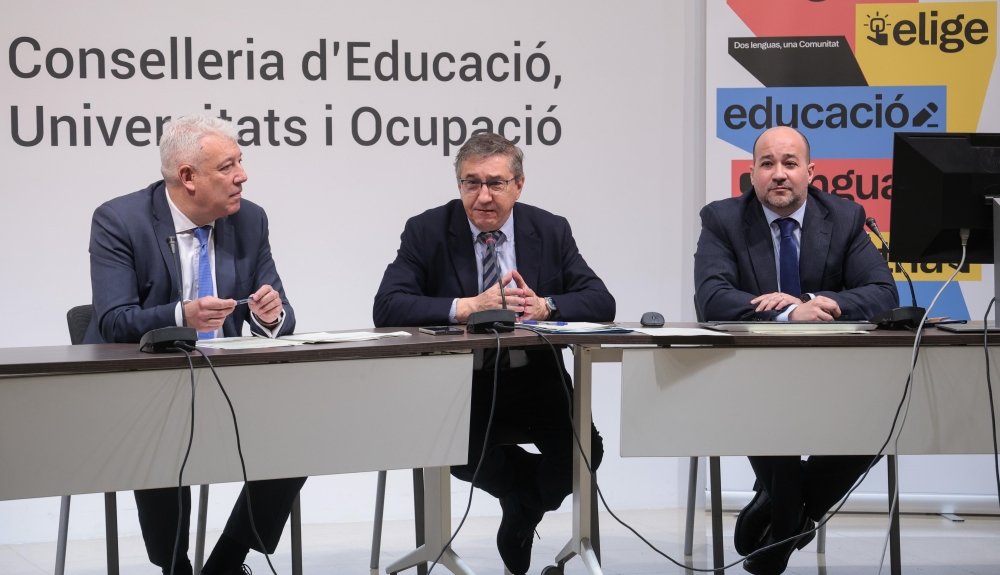Just over 58% participated in base language survey for their children in the Comunidad Valenciana
Families in Xàbia appear to have voted almost 70% in favour of the Valencian language.

58.61% of families who asked to vote in the choice of the base language for their children have participated in the process held between February 25 and March 4. This percentage means that 339,411 families have exercised their right to choose out of a total of 579,082.
The consultation chose the base language – more Castilian or more Valencian – that will be applied from the 2025-2026 academic year. Families of students from public or subsidized schools for Infant, Primary and the first three years of Compulsory Secondary Education (ESO) were called to participate.
The regional minister for Education, Culture, Universities and Employment, José Antonio Rovira, presented the results of the survey at a press conference, together with the regional secretary for Education, Daniel McEvoy, and the general director of Educational Planning and Linguistic Policy, Ignacio Martínez. Rovira has pointed out that this is a “successful” participation rate and has reiterated that educational planning will be based on what the families have chosen.
“Participation has reached (almost) 60%, which represents a very important advance in the representation of families for these decision-making processes, compared to the current situation, where school councils set these programs,” said Rovira. The minister highlighted that in these councils the representation of families is 6 times lower, “since the percentage of participation is close to 10-11% (in the last electoral process of 2023, 10.93% in total participation, 11.41% in public schools and 9.31% in private schools).”
By province, the highest participation has been recorded in the province of Castellón, with 59.81%, followed by Valencia with 58.81% and Alicante with 57.96%.
Participation by Level
The highest participation in the survey was from families of students in Infant Education, from 3 years old to 1st year of Primary Education, which corresponds to families whose children will be in the next school year in what the Law of Educational Freedom calls ‘initial teachings’, in which the key is to learn to read and write, and where the base language has a greater weight.
Participation in Infant Education was 65.92%, reaching 67.86% in the case of three-year-old students. “From Education we have always maintained that families have the right for their children to take these first teachings in their usual language,” said José Antonio Rovira.
As for Primary Education, the participation was 61.27%. From 2nd to 5th year of Primary Education, the participation was between 60-65%. For the rest of the courses, from 6th grade of Primary to 3rd grade of ESO (students who will be in ESO next year), participation was on average 50%.
Participation by Regions
The minister explained that in the regions where the Valencian language predominates, a greater participation has been registered than in those where the Castilian language predominates.
Province of Alicante: El Comtat (73.28%), Alt Vinalopó (57.79%), Baix Vinalopó (62.49%), Vega Baja (46.70%), Middle Vinalopó (62.27%), Alicante (60.92%), La Marina Alta (56.58%), La Marina Baixa (53.95%) and Alcoià (70.21%).
Province of Castellón: Els Ports (67.26%), Alt Millars (55.43%), Alt Palancia (59.60%), Baix Maestrat (52.19%), l’Alcalatén (57.17%), la Plana Alta (61.91%), la Plana Baixa (60.26%) and Alt Maestrat (64.55%).
Province of Valencia: Vall d’Albaida (66.99%), Camp de Morvedre (57.64%), Camp de Túria (60.28%), Rincón de Ademuz (38.32%), Valle de Cofrentes-Ayora (61.90%), Canal de Navarrés (55.07%), Costera (64.82%), Hoya de Buñol (45.17%), Plana de Utiel-Requena (56.61%), Ribera Alta (53.71%), Ribera Baixa (61.38%), Safor (59.57%), La Serranía (54.53%), l’Horta Nord (59.72%), l’Horta Sud (57.06%) and Valencia (60.34%).
Results for Xàbia
According to preliminary results provided by the Ayuntamiento de Xàbia, the preferred choice for the base language is Valenciano (69.9%) as opposed to Castellano (30.1%).
IES Antonio Llido · Valenciano 80.3% / Castellano 19.7%
IES La Mar · Valenciano 63.6% / Castellano 36.4%
CEIP Graüll (provisional) · 99% Valenciano / 1% Castellano
CEIP L’Arenal (provisional) · 50% Valenciano / 50% Castellano
CEIP Mediterranea · Valenciano 66.7% / Castellano 33.3%
CEIP Port de Xàbia · Valenciano 100%
CEIP Trenc d’Alba · Valenciano 100%
Colegio María Inmaculada · Castellano 100%






